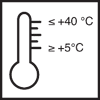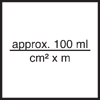Article No. 763060
Elastic joint sealing compound based on PUR synthetic resins
Product specifications
Once fully cured
100% (DIN EN ISO 8339) 0.8 N/mm²
The stated values represent typical product characteristics and are not to be construed as binding product specifications.
Field of application
- Waterproofing in sewage and water treatment plant areas
- Sewage pits, joints in contact with the ground
- Wall areas
Properties
- Resistant to water, seawater, waste water, sewage, weak acids and alkalis
- Resistant to a wide range of solvents, short-term resistance against petrol
- High gas diffusion resistance
- Test report available
-
Preparation
-
Substrate requirements
The sides of the joints must be dry to slightly damp, clean, free from grease and capable of bearing a load, and metals must be sound.
Adhesive primer
Joints subjected to heavy loads - Primer PUR
Underwater areas:
Dry joint edges - Underwater Primer
Slightly damp joining edges - Epoxy MT 100
-
-
Application
-
Application requirements
Temperature of the material, air and substrate: from min. +5 °C to max. +40 °C
-
Cut off tip at an angle to match the joint width.
Apply the material to the joint edges with sufficient pressure.
Pull off using a smoothing agent and a suitable tool.
-
Application instructions
-
Take appropriate measures to protect adjacent building elements and materials that should not come into contact with the product.
Joint dimensions depend on the loading stresses, the building material properties, and the permissible total deformation of the sealant.
The applicable regulations and legal requirements must be observed.
Can be removed while wet with V 101, can only be removed via mechanical means once set.
-
-
Working tools / cleaning
-
Manual or compressed air gun, smoothing tool, adhesive tape
Clean with V 101 while wet.
-
Storage / shelf life
-
If stored unopened in its original container in a cool, dry place and protected against frost, the product will keep for at least 9 months.
-
Usage
-
100 ml/running metre for a joint cross-section of 1 cm²
-
Apply to a large enough trial area to determine the precise amount required.
-
General information
-
Current regulations and legal requirements must be taken into account and deviations from these must be agreed separately.
The relevant test certificates must be observed when planning and carrying out work.
Always set up a trial area/trial areas first.
-
-
Disposal instructions
-
Larger quantities of leftover product should be disposed of in the original containers in accordance with the applicable regulations. Completely empty, clean containers should be recycled. Do not dispose of together with household waste. Do not allow to enter the sewage system. Do not empty into drains.
-
-
Safety / regulations
-
For further information on the safety aspects of transporting, storing and handling the product and on disposal and environmental matters, please see the current Safety Data Sheet.
-










